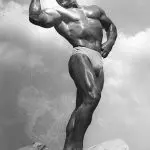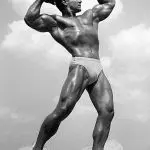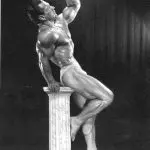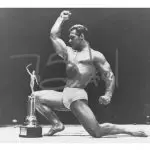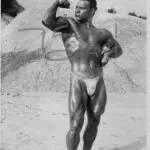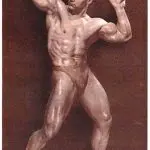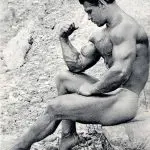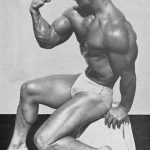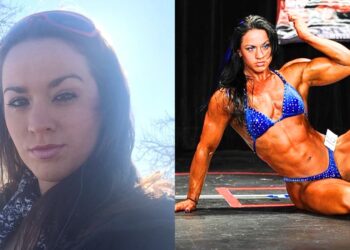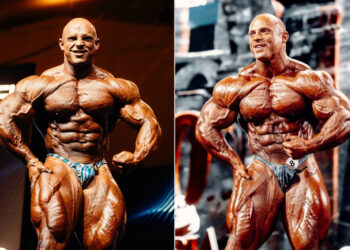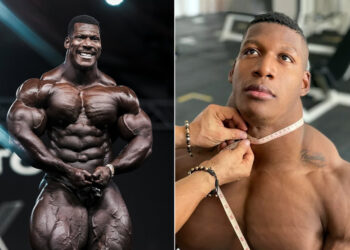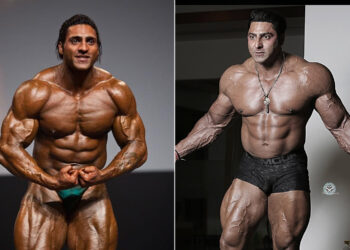John Carroll Grimek was an American professional bodybuilder, Olympic weightlifter, fitness model, and author from New Jersey, USA. He is best known for pioneering modern training methods and dominating the competitive bodybuilding scene in the 1940s era. This article explores his biography, competition history, and workout routine.
John Carroll Grimek
Born: June 17, 1910
Died: November 20, 1998
Birthplace: Perth Amboy, New Jersey, USA
Nickname: Monarch of Muscledom
Height: 5′ 8″ (175 cm)
Weight: 195 lbs (89 kg)
Chest: 47″ (119 cm)
Arms: 17,5″ (45 cm)
Waist: 31″ (79 cm)
Thighs: 25″ (64 cm)
Calves: 17″ (43 cm)
John Carroll Grimek Biography
Early Life
John Carroll Grimek was born to Slovakian immigrant parents on June 17, 1910, in New Jersey, New York. Grimek started weight training at 12 when he would sneakily train with his father’s weights when nobody was around to see. This was primarily because he was afraid to be embarrassed if his form was not good.
Grimek’s father and older brother were the inspiring figures in his life and he looked up to them for motivation. In those days, bodybuilding and weightlifting were not popular sports and Grimek trained weights with a simple goal of becoming bigger and stronger.
However, the legendary bodybuilder turned towards Olympic weightlifting eventually and it soon became clear that he had a promising future in weightlifting and bodybuilding.
Level Up Your Fitness: Join our 💪 strong community in Fitness Volt Newsletter. Get daily inspiration, expert-backed workouts, nutrition tips, the latest in strength sports, and the support you need to reach your goals. Subscribe for free!
Olympic Weightlifting Career
John Carroll Grimek qualified for the US Olympic weightlifting team for the 1936 Berlin Olympics and represented his country on the grandest stage of sports and athletics. Grimek finished ninth in the heavyweight division. He lifted 115 kg (253 pounds) in the military press, 105 kg (231.5 pounds) in the snatch, and 137.5 kg (303.18 pounds) in clean and jerk.
Experts were thoroughly impressed with Grimek’s performance and many suggested that he could probably have won the gold medal if he competed in the light heavyweight division instead of heavyweight.
Fitness Modeling to Survive During Economic Crisis
John Carroll Grimek was consistently working to improve his physique and he was noticed by several professional photographers and brands willing to sell their products. He soon became a much sought-after fitness model and appeared on the covers of several magazines. He also endorsed a lot of products.
This career option helped him greatly during the great depression and Grimek was able to support his family when the earning opportunities were limited.
Switch to Bodybuilding
In the years after the Olympics and fitness modeling, John Grimek shifted his focus toward bodybuilding and won the 1939 York Perfect Man competition. He then went on to dominate the bodybuilding scene for the entire decade from 1941 to 1949, winning every competition he participated in.
Grimek was the only bodybuilder to win the Mr. America competition twice – in 1940 and 1941. Grimek was so far ahead of his time and above the rest of the competitors that the organizers had to create a ‘one victory only’ condition in the rulebook so that Grimek could not repeatedly win the competitions, dominating the bodybuilding scene singlehandedly.
Grimace continued to win competitions well into his late 30s and won the 1948 Mr. Universe in London. Grimek defeated the great Steeve Reeves in the posedown to secure the victory. Years later, he revealed his strategy to get an edge over his competition.
It became clear that Grimek, Reeves, and a French bodybuilder were going to be in the final posedown. The French bodybuilder went first and wrapped up the routine after a couple of poses. Grimek followed next and presented an astonishing 30-pose routine.
“As a conclusion, I jumped off the pedestal into a full split, and did a handstand, a couple of handstand push-ups and flipped back to my feet.”
Grimek’s posedown was nothing like anyone had ever seen before and the entire venue was on fire. Reeves, who went last, felt the pressure after Grimek set the bar so high. Grimek explained that he appeared to be visibly nervous and faltered along the way. This convinced the judges that Grimek deserved the victory.
After winning the 1949 Mr. USA competition the next year, John Carrol Grimek called it a career.
Life after retirement
John Carroll Grimek wrote for a variety of bodybuilding publications and health magazines after retiring from competition. He continued to train long after retirement and led a healthy life.
Although Grimek was one of the most dominant bodybuilding competitors of his generation, becoming one was not his initial ambition. If at all, Grimek did not like some bodybuilding enthusiasts’ attitude and self-obsession. But he was driven by results and accepted his bodybuilding success as a by-product of it.
Those who met John Carroll Grimek as a humble person who treated everyone with respect. Grimek lived a fulfilling life and left this world on November 20, 1998, at 88 years of age. He was buried at the Holy Saviour Cemetary in Manchester Township, York County, Pennsylvania.
Competition History
- 1936 Olympic Games Weightlifting – 9th place
- 1939 York Perfect Man – 1st place
- 1940 Mr. America – 1st place
- 1941 Mr. America – 1st place
- 1946 Most Muscular Man In America – 1st place
- 1948 Mr. Universe (Categories “Short” and “Overall”) – 1st place
- 1949 Mr. USA – 1st place
John Carroll Grimek Workout
John Carroll Grimek was involved in both bodybuilding and weightlifting. The training principles he followed for these workouts are still relevant today. Despite being nearly a century old, Grimek’s training routines and exercises were not vastly different from the bodybuilding workouts of today.
While speaking about his training routines, Grimek once said:
“I trained everything in every workout. I didn’t do what they call split workouts and train legs and arms one day, back and other stuff the next day. The only way I ever isolated a group of muscles was when I was finished with my routine for the day and I still thought I needed more for my back or chest or legs or whatever.”
Grimek’s workouts mostly consisted of compound movements but also had room for isolation exercises. He worked all the muscle groups in each training session and generally performed three sets of each exercise, with 10 reps per set.
The legendary bodybuilder trained three days per week and ensured that he made adequate progress in terms of weight. Grimek gave utmost importance to rest, recovery, and hydration – taking three to four days off every week.
Training Split
Monday
- Bench Press – 3 sets of 10 reps
- Chin-Ups – 3 sets of 10 reps
- Military Press -3 sets of 10 reps
- Barbell Curls – 3 sets of 10 reps
- Squats – 3 sets of 10 reps
- Standing Calf Raise – 3 sets of 10 reps
Wednesday
- Incline Bench Press – 3 sets of 10 reps
- Barbell Row – 3 sets of 10 reps
- Shrugs – 3 sets of 10 reps
- Single Arm Preacher Curl – 3 sets of 10 reps
- Leg Curl – 3 sets of 10 reps
- Sit Ups – 1 set of 50 reps
Friday
- Pull Downs – 3 sets of 10 reps
- Military Press – 3 sets of 10 reps
- Incline Dumbbell Curl – 3 sets of 10 reps
- Front Squats – 3 sets of 10 reps
- Stiff Legged Deadlift – 3 sets of 10 reps
John Carroll Grimek Diet
Like most bodybuilders who need to feed their massive physique with proper nutrition to build and sustain muscle mass, John Carroll Grimek needed to eat massive amounts of food.
He was known for being a big eater when following an intense training split. While he was not overly restrictive about his diet when he was not preparing for a competition, Grimek restricted himself to nutrient-dense foods that gave balanced amounts of proteins, fat, and carbohydrates. He also ate plenty of vegetables to get vitamins, fiber, and other micronutrients to meet the body’s requirements.
To Conclude…
John Carroll Grimek achieved great success in different fields like bodybuilding, Olympic weightlifting, fitness modeling, and fitness writing. But surprisingly, achieving competitive success in any of these fields was never his primary goal.
Instead, it was a by-product of his consistent efforts to get strong, athletic, and big. His success proves that as long as you stay committed to the craft, competitive and commercial success will come as an inevitable outcome.

